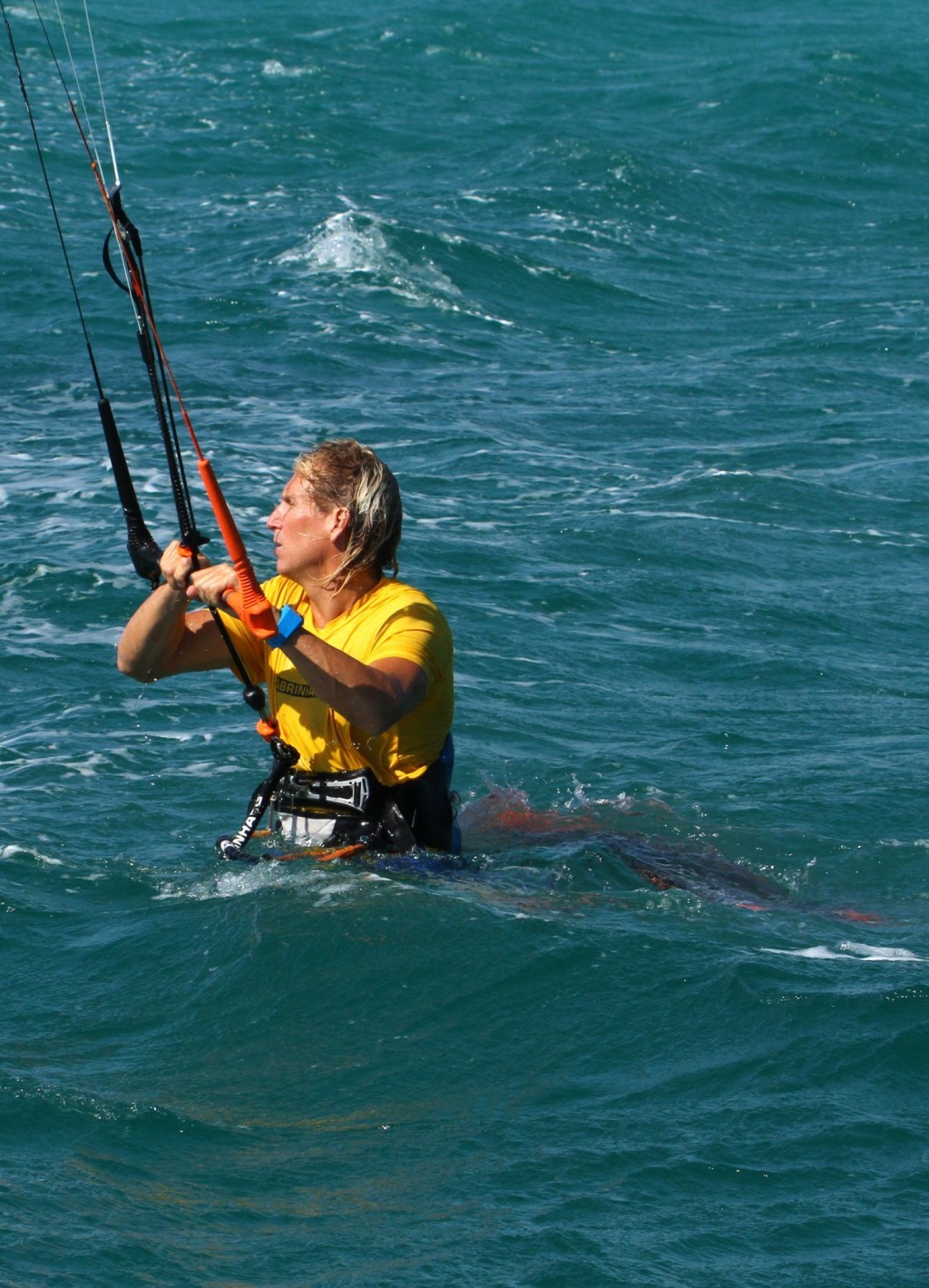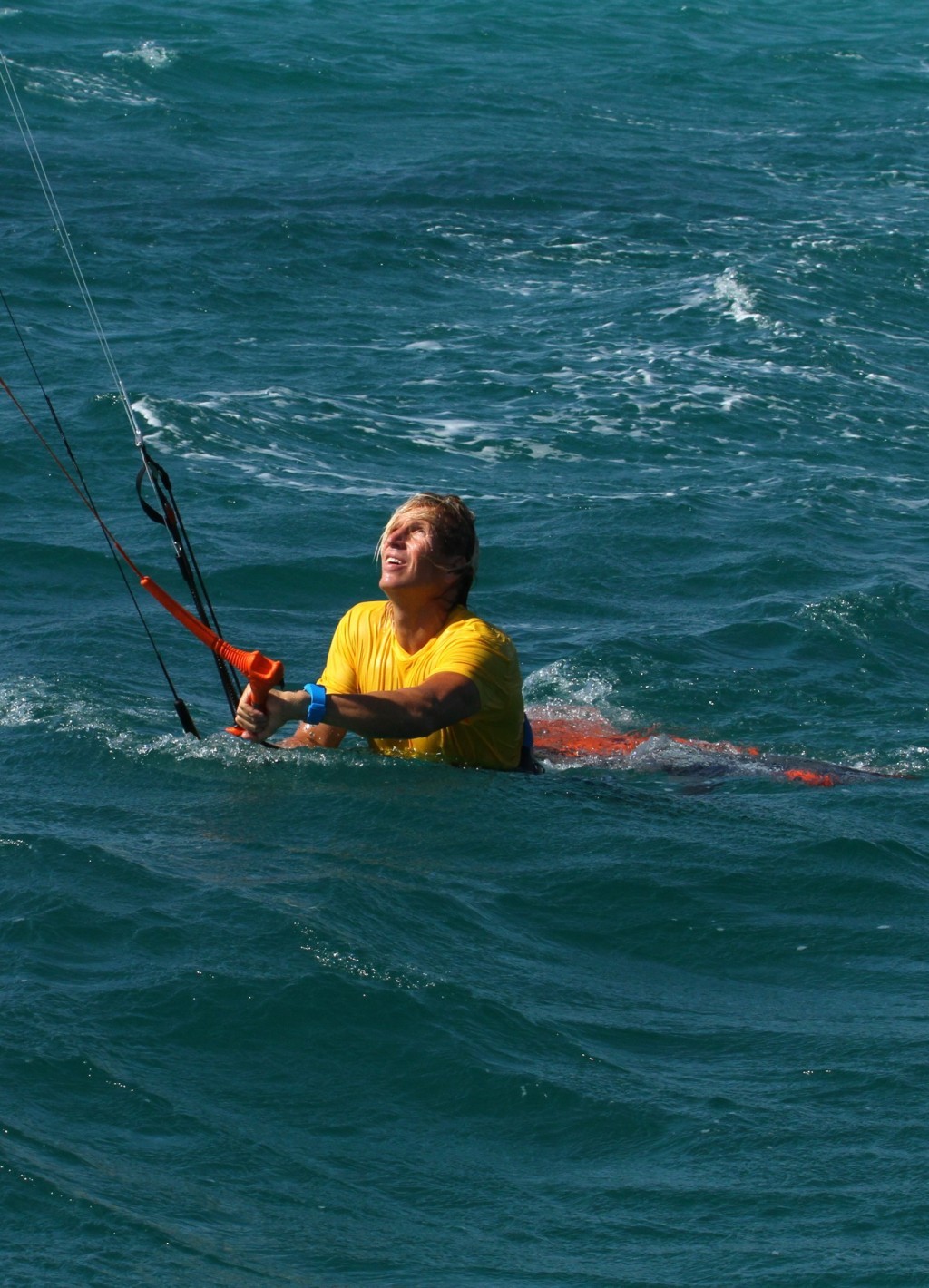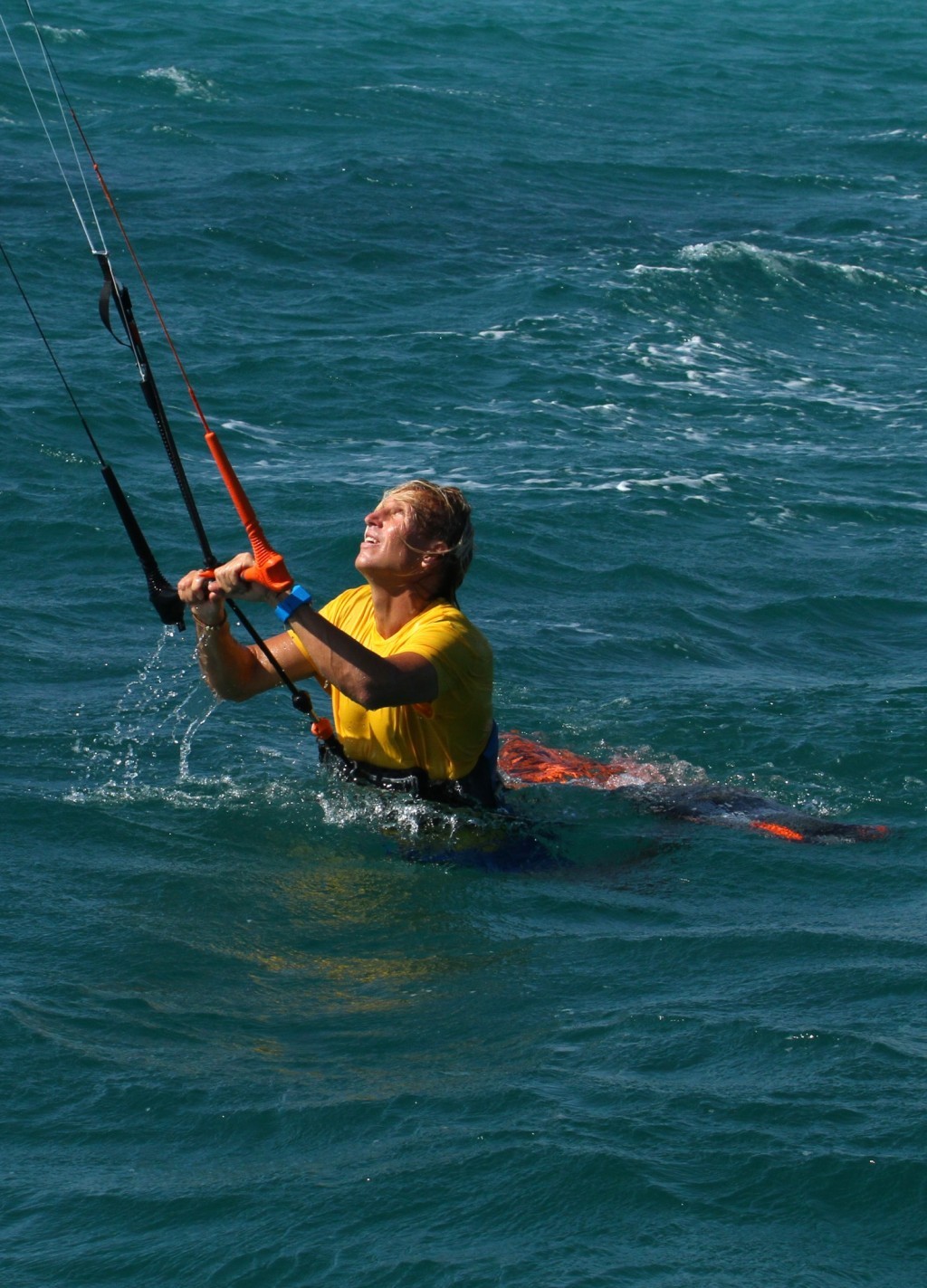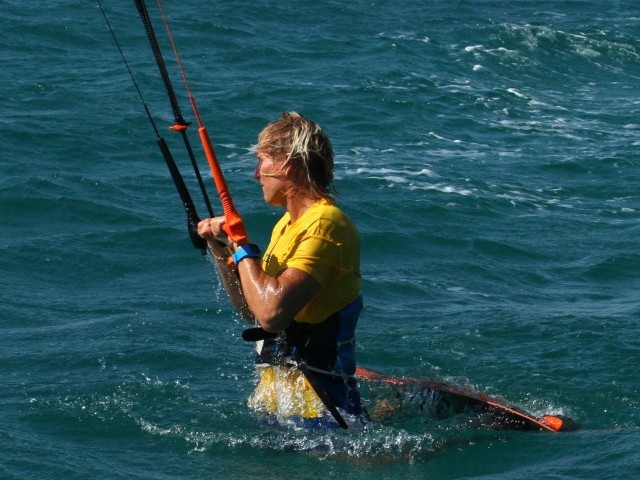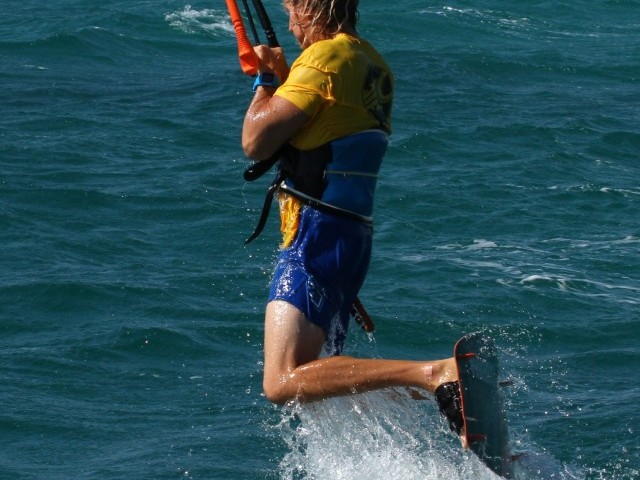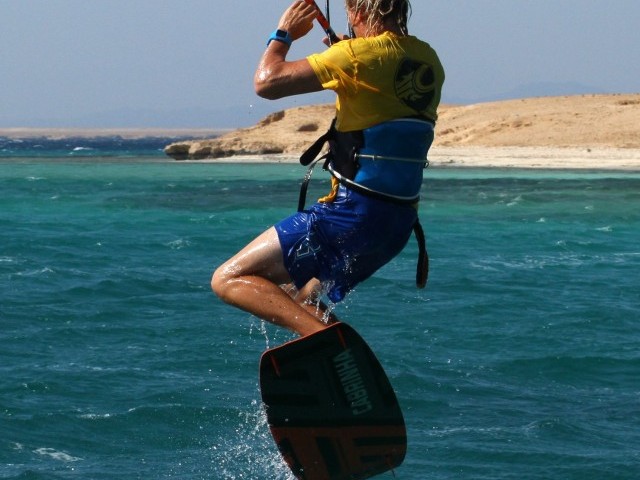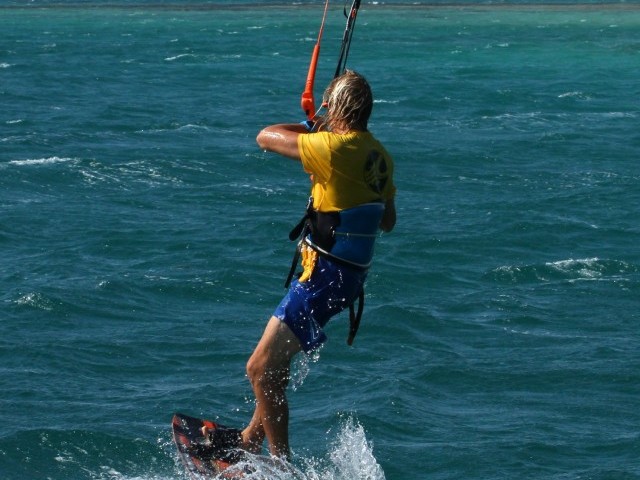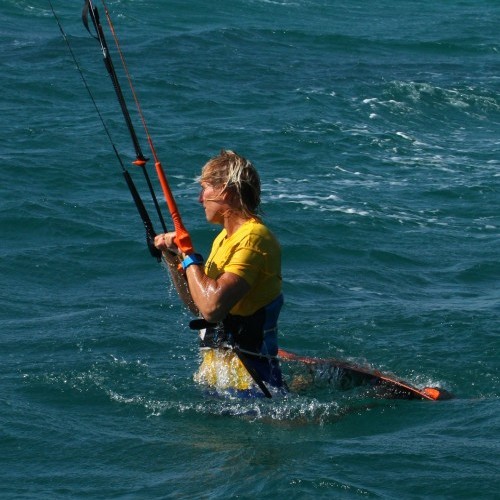
Board Behind Waterstart
Technique / Intermediate
Introduction
Stylish and practical, definitely two words that fit this down to a T. Stylish because what better way can there be to regain your pride after a wipe-out, other than just boosting back up into the air from which you fell and scooting gracefully off. Practical as most of us spend a lot of time getting back on the board and this one relieves your abs of their constant and exhausting task of pulling the board back under you after each and every dunking. It’s also a bit of a precursor to moves like the jumping beach start and will also give you a good feeling for when you come to learn the dark slide. That should hopefully be enough to tempt you?
By way of an additional forward, this is most handy and practical should you fall and find yourself with the board still attached and behind you. The only prerequisite for this may be the ability to jump, even if only baby ones, as you’ll have an idea of what the kite should be doing and how to land. Right, let's have a look at the bits that make this possible.
A New Beginning Pic A
So you’re in the drink, your feet are in the straps, and the board is behind you. The good news is that you no longer need to abuse your stomach, but rather use the wind. Regardless of wind strength, gusts, lulls, sea state or anything else that mother nature cares to hurl at you, the pre-start checklist remains the same. First off your board is securely on both feet and is, therefore, unlikely to come off when you launch yourself from the water. Secondly, your sweet spot needs to be trimmed out away from you. This will not only help you get more lift, but more importantly, it will enable you to man handle the bar as it will be up in front of you. If the sweet spot is down near the chicken loop, the bar and your hands will feel too low, they’ll be out of sight under water, and you’ll feel less balanced. Assuming that the above is correct you now need to work out which way you’ll go and check to see if the coast is clear. Christian will go right, starboard, so he has a good check. All this can be done with the kite at 12 o’clock, but if it’s very windy slightly to one side or the other will keep you in the water.
The Set Up Pic B.
As you can well imagine, if there is most of you and your board in the water, you’re likely to create a far amount of drag and resistance. This means that you do need to move the kite for assistance. Think back to the early days, or your first lessons. More often than not you’d try to dive the kite from 12 o’clock and either not much would happen or if there was enough power the kite would go flying straight down towards the ocean and you’d get pulled over the figurative handle bars. The chances are that if your instructor was worth his or her fee, they’d then tell you that you “still” needed to start with the kite behind you, or rather behind 12. Meaning that if you were going right, your kite needed to be back towards 11, and if you were going left back towards 1 o’clock. It’s the same here, and the same rings true that it’s better to start with too little and then slowly ramp it up rather than moving the kite too much. To set himself up here, Christian has slowly moved the kite to his left, so it creeps around the edge of the window to about 11:30 (it’s quite windy). If he moves or you move the kite quickly you’ll be lifted, and you don’t want the lift yet, so slowly does it. Once the kite is back where you want it, you can then send it forwards with more meaning. You can see that Christian has been quite positive with his bar, as he’s trying to move the kite quickly and he keeps the bar out on the sweet spot as he doesn’t want the kite to stall.
Now’s the Time Pic C.
If you look at this pic, it’s a continuation of the last point. Christian has given the kite the command to move with meaning, and he’s watching it like a hawk to make sure that it turns fast but goes up over 12 rather than overdoing it and diving it down. In this scene 12 is your magic number. With the kite going over and past 12 the kite is already lifting Christian so his upper body raises out of the water. This moment of lift is your cue…
To Pull the Bar Pic D.
With the kite moving overhead Christian pulls down on the bar for some extra lift. The chances are that this will stall the kite a bit so the pull will be both upwards and downwind. At this moment your want to tense your core and be ready for the pull, as with the board lying behind you in the water there will some resistance to you going up. Now Christian is looking forwards in the direction in which he’ll travel. This will keep him, and you, balanced once you take off. Also by pulling down on the bar you will be levelling it, so the kite will stop moving forward.
The Big Chill Pic E.
As the kite lifts you out of the water, you want to stop it somewhere around 12. Much like you would in a jump, but the main difference being that your objective is to take the kite from one side across to the other. However, at this moment you want to press the pause button. This way all the energy will be up, you’ll have tension on the lines, and you’ll be in a position from which you can then orchestrate the landing, so keep the bar level. The other point here is not to do much with your legs - yet. The reason for this move, other than looking and feeling great, is that you’re trying to save your poor abs. If while the kite is pulling you up and through the water, you try and pull the board underneath you, you’ll actually have more resistance than if you were stationary in the water. So leave your whale tail behind you until the board is clear, just like Christian is here.
The Dive Pic F.
Just like a standard jump, you’ll want the kite to pull you downwind so that you can turn the board to follow it for a smooth, marshmallow landing. The only way to achieve this is to dive the kite hard down through the window. Just like a jump timing is key here, so wait with the kite at 12ish until you’re dropping. Then once you’re close to the water dive the kite hard. Do however make sure that you have your knees up and the board underneath you before you dive.
The Reception Pic G.
And again just as per a jump your aim is to land slightly tail first with the board pointing downwind and the kite diving. So hopefully this will be second nature by now? Take the landing by standing up over the board, and once you are balanced, you can then carve back onto your edge and continue as if nothing happened.
Top Tips
Aside from making sure that both your feet are firmly in your straps, you will need more oomph than you think to get up and out of the water. Trim your sweet spot out, so that the bar will remain above the water when you send the kite, and you’ll get a bit of extra stall lift when you pull the bar in. That said it is better to build up to the perfect take off, rather than fire yourself straight into orbit on your first attempt, so start off with the kite just behind 12 and see what happens. If you don’t feel much, take it back a bit further for the next attempt.
Take in the sequence and videos to get a feel for the bar movement and timing.
Common Problems
The most likely problem is not getting enough lift. If this is the case take the kite back further before sending it up and over.
If you’re getting dragged hard forwards but not getting lifted out, it means that you’re diving the kite when you send it. Think of turning it quickly to make it move but then let off so that the kite goes via 12 o'clock.
If you’re landing nose heavy or falling to the side as you land, this means that the kite has crept too far round the edge of the window, so it’s now too much to the side you are going. Make sure you level the bar and stop the kite at 12, and then make sure you give it a decent dive to land.
Keystones
- Move the kite slowly back towards 11 or 1
- Turn the bar aggressively to move the kite quickly up towards 12.
- As the kite lifts, pull the bar in and level it
- Wait to clear the water before bringing knees up.
- Dive hard for a downwind landing as per a jump
This technique article was in Issue 59 of IKSURFMAG.
Related
By Christian and Karine
Christian and Karine have been working together as a coaching team, running improver to advanced kitesurfing clinics since 2003.







